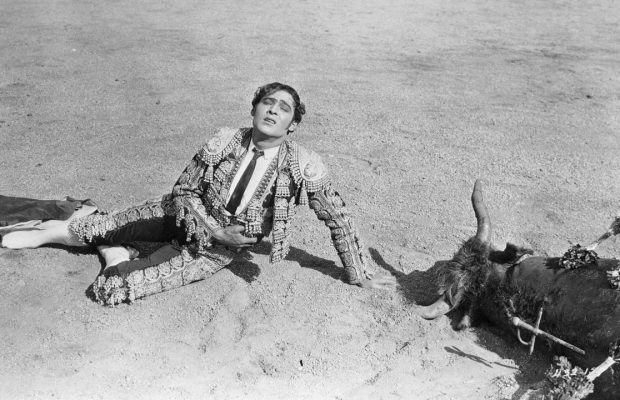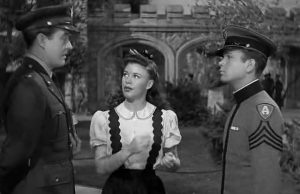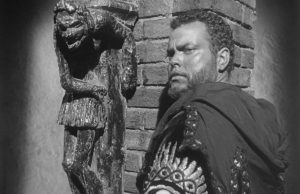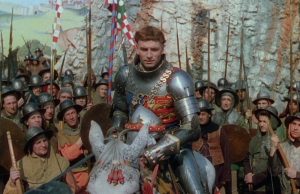Blood and Sand (1922)

Toronto Film Society presented Blood and Sand (1922) on Monday, November 18, 1963 as part of the Season 16 Monday Evening Silent Film Series, Programme 2.
Programme No. 2
(Monday, November 18, 1963)
Two Aspects of Bullfighting
CHARLIE CHAPLIN’S BURLESQUE ON Carmen (50 min)
Intermission
RUDOLPH VALENTINO in Blood and Sand (80 min)
(Should end 10:50 approx)
If you like coincidence, take note of the fact that the month of December, 1913, contained the beginnings of a new life for both stars of tonight’s program. Charles Chaplin arrived in Hollywood to begin work on his first film contract; and an 18-year-old Italian immigrant named Rodolfo Alfonzo Rafaelo Pierre Filibert Guglielmi di Valentina d’Antonguolla landed in New York, to see his fortune in the New World. Though nobody knew it in December 1913, these two moves were destined to bring happiness to millions of people the world over.
* * *
Carmen (4 Reels. Released by Essanay, April 22, 1916)
Written and directed by Charles Chaplin
Photographed by Rollie Totheroh
Players: Charles Chaplin (as Darn Hosiery), Edna Purviance (as Carmen), Ben Turpin (as Renandados), John Rand (as Escamillo), Jack Henderson (as Lilies Pastia)
In 1915 two film companies came out with their versions of Carmen; one starring Theda Bara, and the other the very popular opera star, Geraldine Farrar. The latter, directed by Cecil DeMille, with Wallace Reid as Donn José, was one of the big box-office hits of the year. Chaplin decided to get into the act with a take-off on it (the sets and much of the action were based on the DeMille version). The film was intended as a two-reeler, to be released in December 1915; but by that date Chaplin had left Essanay (see below), and the company decided to turn it into a “feature” by using material that Chaplin had discarded and by shooting an independant subplot involving Ben Turpin and the gypsies, intercutting it with the original film. This tampering weakened the film, and Chaplin promptly sued Essanay (who promptly slapped him with a countersuit for failing to complete the number of pictures stipulated by his contract).
If this film fails to come up to the level of Chaplin’s other comedies of this period, that’s why.
* * *
Charles Spencer Chaplin was born in London on April 16, 1889. His people were vaudevillians, and the boy was in show business from early childhood through sheer economic necessity. At 17 he joined a famous music-hall troupe, The Fred Karno Company, which in 1910 sent out a second company to the United States with Chaplin as its leading comedian, (Stan Laurel was another member), where it was so successful that it continued to tour the States for several years. In the summer of 1913, as an outcome of performances in Los Angeles, Chaplin was offered a film contract by Mack Sennett. Films, about which he knew nothing, didn’t attract him, but the salary of $150 a week, three times his current salary, did. (Chaplin’s impoverished childhood gave him a healthy respect for money). He signed a year’s contract with the Keystone company, to be effective as soon as he finished his commitments with Karno at the end of November, 1913.
Chaplin’s rapid rise in films is quickly summarized: though he knew nothing about films when he arrived, within five months Sennett was letting him write and direct all his own pictures. When the contract expired at the end of 1914, he signed a year’s contract with the Essanay Company for $1,250.00 a week. At the end of that year he signed a contract with the Mutual Company for $10,000 a week plus a bonus of $150,000 just for signing. (and remember, these were only for two-reelers!) Thus quickly did the public discover Chaplin.
At the end of his contract with Mutual he went into production for himself, at first releasing through First National, and subsequently through the company he helped to found: United Artists. The films he made for his own company he still owns, and he jealously controls their use. This is why the only films available to Film Societies and other exhibitors are the ones he made for Keyston, Essanay and Mutual.
EDNA PURVIANCE was born in Nevada in 1894. Chaplin discovered her in San Francisco and she became his leading lady through all his Essanay, Mutual and First National films and A Woman of Paris. She retired not long after that, but Chaplin kept her on his payroll almost until her death in the 1950’s.
* * *
RUDOLPH VALENTINO (to use the simplified version of his baptismal name that he later adopted) was no penniless immigrant when he landed in America. His father had been a well-to-do farmer and veterinarian; his mother was a Frenchwoman, daughter of a Paris surgeon; and the boy, born in Castellaneto, Italy, on May 6, 1895, had graduated from the Royal Agricultural School in Genoa. Having disgraced his family by a minor escapade in Paris, he was shipped off to America, where he arrived, two days before Christmas, 1913, with a tidy lump sum to tide him over till he got a job,–presumably in some form of agriculture or gardening. He had no relatives there, but he soon made good friends in New York, and had a very good time there for several months until his money ran out and he was reduced to sleeping on park benches.
As it turned out, those prodigal months had not been altogether a waste. From his sociable friends he had picked up the latest ballroom dances, including the highly fashionable tango. A born dancer, it came so easily to him that he thought nothing of it; but for the rest of his life his dancing would be something he was to fall back on in time of need, even during the height of his fame as a film star. In 1914 it saved him from starvation: he got a job as a gigolo in Maxim’s restaurant in New York; this led to his becoming the partner of a popular vaudeville dancer, Bonnie Glass (who needed him to replace her previous partner, Clifton Webb). His dancing tours took him to California, where at a friend’s suggestion he began looking for work in the movie studios,–mainly as a way to raise enough money to buy himself a farm. He played bits; managed to play leading men opposite Carmel Myers and Mae Murray; but his unmistakably foreign face mostly led him to be type-cast for villain roles, (such being the outlook in the U.S.A. at that time). Not until 1920 did someone realize that his exotic looks could be turned to advantage. The scenario writer June Mathis saw him in a minor role as a dancing master in Eyes of Youth, and decided that this was the ideal actor to play the tango-dancing Argentine in The Four Horsemen of the Apocalypse, which she was adapting to the screen for production by Metro.
* * *
Blood and Sand (Produced by Famous Players-Lasky; released Sept. 1922)
Adapted from the novel by Vicente Blasco Ibañez
Screenplay by June Mathis
Directed by Fred Niblo
Players: Rudolph Valentino, Lila Lee, Nita Naldi
Likewise sitting on their shelf for the same reason were the rights to “The Sheik”, a popular novel by E.M. Hull, which Lasky had purchased at the urging of his (female) secretary, and then didn’t know what to do with.
Earlier in that year, 1921, on or about March 6, Jesse Lasky had attended the premiere of the film version of The Four Horsemen of the Apocalypse; and even though it was the product of a rival company, Metro (not yet Metro-Goldwyn-Mayer), he was as thrilled by it as he had been six years earlier by The Birth of a Nation. He was also very impressed by the unknown young Italian actor who played the leading role, and he wished ruefully that this Rudolph Valentino had been discovered by his own company instead of by Metro.
Great was his astonishment when, a few months later, Rudolph Valentino called on him in person, looking for work. Incredible as it seems, Metro, not realizing they had a gold mine in their hands, had not bothered to put him under contract. He had made three more pictures for them, but all at the same salary at which, as an unknown, he had been grudgingly entrusted with the leading role in The Four Horsemen, which was now proving such a smash hit all over the country.
If Metro wasn’t interested in him, Lasky certainly was, and lost no time in signing him up; and then set about to find suitable material for him. It was once again his (female) secretary who pointed out that he already had the perfect part for Valentino waiting on the shelf.
The Sheik (released Nov. 1921) was the film that made Valentino. Trash though it may have been, its not-yet-hackneyed tale of a white Sheik of the desert who kidnaps an English girl had already thrilled thousands of female readers, and its embodiment on the screen by this incredibly handsome man whose exotic personality blended sleekness and savagery, had an intoxicating impact on the women of that time, puritanically brought up to resist advances, but secretly hoping to be raped. American women, starved for romance by their work-a-day, prosaic husbands and sweethearts, found in Valentino the dream lover whose attitude toward women was an excitingly delicate balance between worshipful respect and ruthless seduction.
The Sheik had a far-reaching importance out of all proportion to its doubtful merits as a film, launching a new vogue for desert pictures, a new conception of screen lovers, and a new slang word. (As late as 1926 the long-popular musical comedy, The Desert Song, was reflecting this post-Sheik world).
It was followed by two lesser films, Moran of the Lady Letty and Beyond the Rocks (the latter co-starring Gloria Swanson), before Famous Players got round to the other property which had been unwittingly purchased for Valentino.
* * *
Every care was taken to make Blood and Sand a special film. June Mathis, who had done so well for The Four Horsemen and for Valentino, was engaged to do the screen adaptation. Costumes and bullfighting equipment were imported from Spain and Mexico. A retired matador coached Valentino in the art of the Corrida. Valentino immersed himself in the character, as he always did.
Valentino may not have been a great actor, but he was a good one, and he does seem to have taken his work very seriously. The fact that off-screen he registered only as a nice Italian boy seems to suggest that his screen personality and sex-appeal can be at least partly credited to his histrionic ability. Some ofhis emtional scenes may seem exaggerated (though probably natural to an Italian), but in the deliniation of character, withint he scoopeoffered him, he was always considerably better than adequate; and no picture offered him greater scope than Blood and Sand. His performance as Juan Gallardo was praised by Ellen Terry.
Of all the pictures he was ever in, before or afterwards, Blood and Sand was probably the best. And in addition to being a good film in its own right, the role was a perfect vehicle for Valentino’s talents.
* * *
Looking back on it, we can see that when he made Blood and Sand Valentino was at the peak of his film career. The next few years are frustratingly tragic to contemplate. And ironically, as in Blood and Sand, his downfall was caused by a woman.
As soon as filming on Blood and Sand was over, Valentino married Natacha Rambova, whom he had met when he played Armand in Nazimova’s film version of Camille, shortly after The Four Horsemen. Rambova (her real name was Winifred Shaunessey and she was the step-daughter of the cosmetics king, Richard Hudnut; she acquired her Russian name while a member of Theodore Kisloff’s ballet company) was Nazimova’s art director, and not only designed the sets and costumes but also made all the vital decisions. (She later did the same for Nazimova’s astonishing and controversial Salome). Valentino fell deeply in love with her, and although she seems to have been more in love with a career than with him, they were ultimately married; and Natacha began at once to make herself the power behind her husband’s throne,–managing him, be it said in her defence, not for material gains but out of lofty artistic ideals.
Blood and Sand was followed by an insignificant item called The Young Rajah and then Valentino rebelled. He insisted on having full right of approval on all stories assigned to him; and when the studio refused, he walked out. And as he was still under legal contract, Famous Players slapped an injunction on him that prevented him from making films for anybody else.
Valentino was off the screen for nearly two years, during which time, with Natacha as his partner, he went on a dancing tour (sponsored by a beauty cream manufacturer) that was so successful that Famous Players eventually capitulated and took him back on is own harsh terms.
There is no denying that Natacha Rambova was a great designer; her worst enemies concede that. Unfortunately she also believed herself to be omniscient in all matters of production; and with her husband’s loving approval she insisted on supervising every detail of his films; and the company got so fed up with this irritating interference that after only two films, Monsieur Beaucaire (Aug. 1924) and A Sainted Devil (Nov. 1924), whose box-office returns indicated that Valentino’s popularity was well below its former level, they were quite happy to sell the contract to an independent producer…who made one film, Cobra, and then likewise threw up his hands in despair and frankly broke his contact. United Artists then offered Valentino a very good contract, but made one firm stipulation: Mrs. Valentino was to keep strictly out of it. Desperate, Valentino signed it. Hurt by this “betrayal”, the woman whom all women envied quickly lost interest in him; divorce followed not long afterwards.
Now under proper management, Valentino’s career took a turn for the better. The Eagle (Nov. 1925) began rounding up the fans who had loved him once but had become more discriminating. An attempt to cash in on his former glory by filming its sequel actually worked: released in July, 1926, The Son of the Sheik was an immediate hit. Valentino was sent east to make personal appearances with its New York opening. Everywhere he went the fans mobbed him.
For several months Valentino had been plagued with mysterious sharp pains; but with his native distrust of doctors he ignored these symptoms, suffereing in silence till they went away. Suddenly, on August 15, he collapsed and was rushed to the hospital where he was operated on for appendicitis and gastric ulcers; but it was already too late. Daily front page headlines chronicled his gradual recovery and then his sudden turn for the worse. He died of peritonitis on August 23, 1926, at the age of 31.
With perfect timing, Valentino died at the beginning of an upswing of renewed popularity, thereby ensuring its permanence. His five year career as a screen idol, in spite of its brilliant moments, is a sad record of fumbled opportunities and tragic mismanagement; but he bought atonement for this with his life.
* * *
NITA NALDI was born Donna Dooley in New York City, and bega her career as a show girl in Shubert revue at the Winter Garden. John Barrymore brought her to the screen in his Dr. Jekyll and Mr. Hyde (1920). In addition to Blood and Sand she played opposite Valentino in A Sainted Devil and Cobra. Other films included Glimpses of the Moon, The Ten Commandments et al. She died in New York early in 1961 at the age of 63; except for an occasional television appearance she had been living for the previous 25 years in virtual seclusion in a room at the Hotel Wentworth, where her room was paid in part by the Actors’ Fund.
LILA LEE was born Augusta Appel, and was “an adorable thirteen-year-old youngster” appearing in a vaudeville revue with Gus Edwards when a talent scout from Famous Players spotted her. Lasky signed her, and with his self-admitted passion for giving his discoveries new names, appropriated “Lila Lee” from a line of poetry that was running through his head, and sent her off to Hollywood, where she remained prominent in films till at least the end of the 1920’s. Last year’s members will remember her in Male and Female. She married another screen star, James Kirkwood, and their son, James Kirkwood Jr., has had some success as a writer, including a novel about Hollywood.
Notes by Fraser Macdonald















Leave a Reply